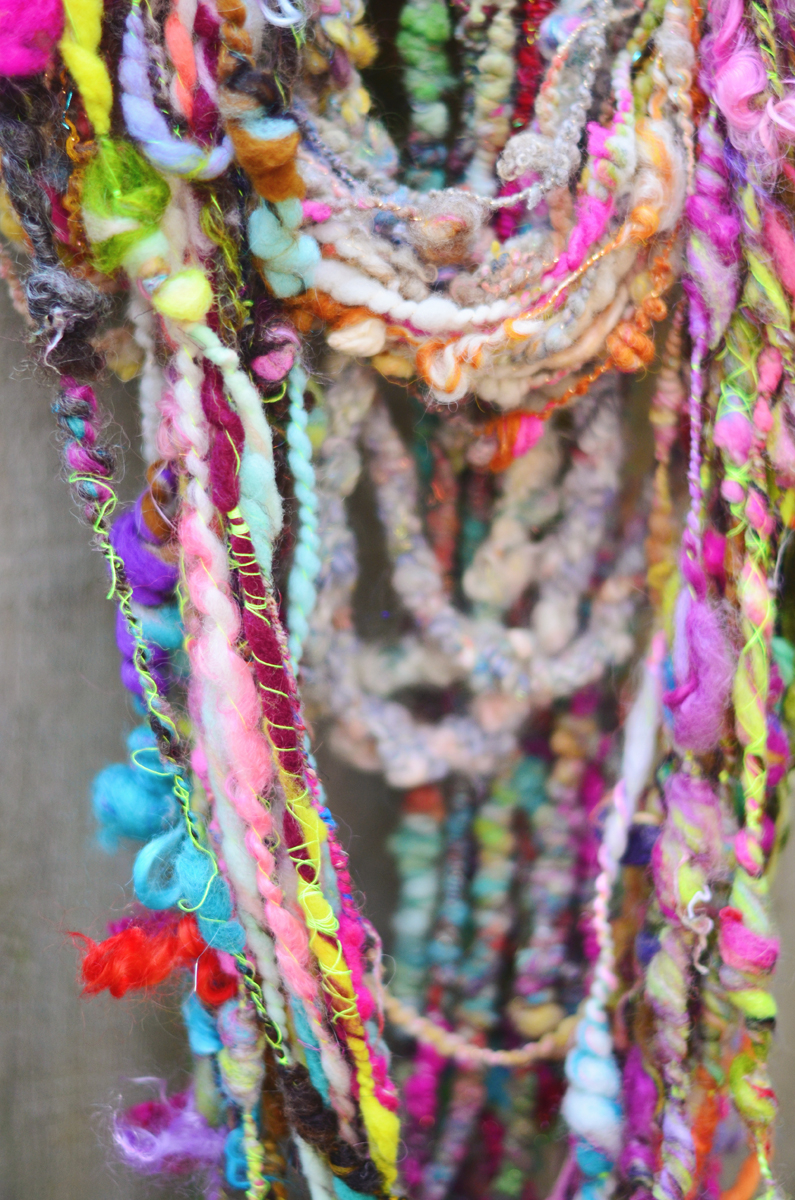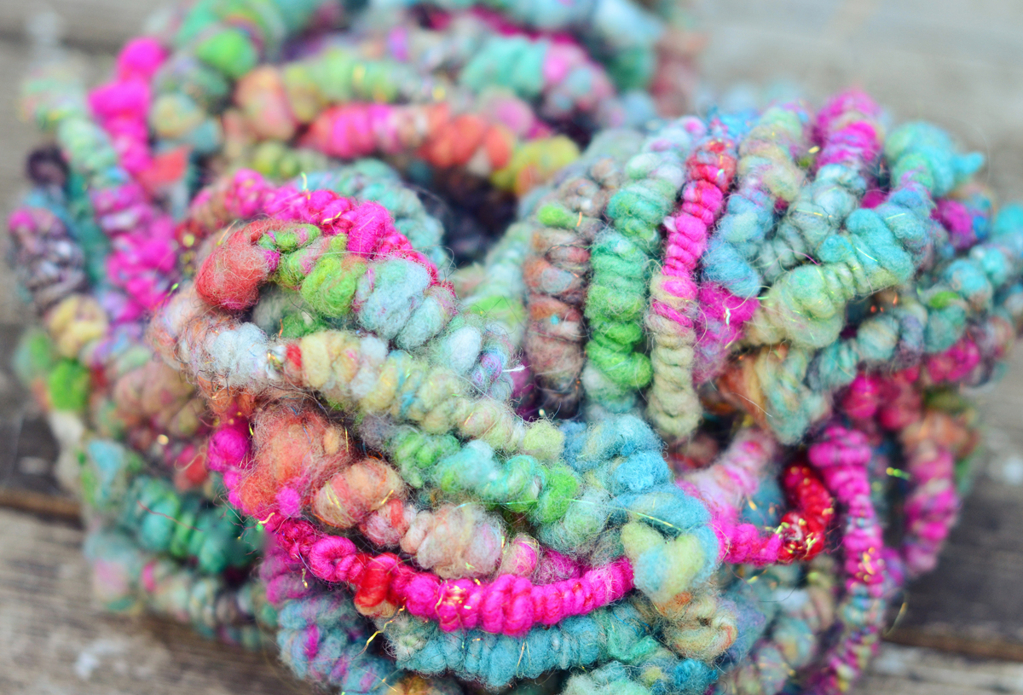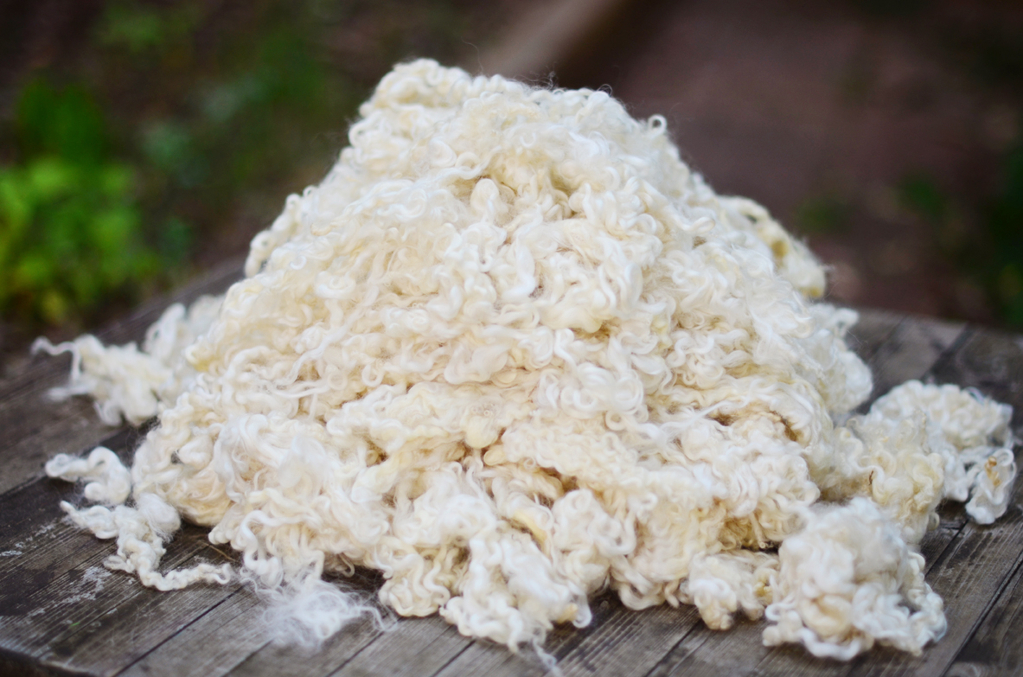Why Buy Handspun Yarn?
Handspun Art Yarn
I get asked this question sometimes and I try not to get too irritated from a question that seems to challenge the value of what I do as an artist. But... for the uninitiated, it’s kind of hard to answer without sounding snooty, so the best analogy I can think of is “why do people choose a gourmet meal over fast food?”. It’s not the kind of thing you’d eat every day unless you’re a really good cook and have the time and can afford the best ingredients. It’s more expensive and time consuming to make, and just like high end food, handspun yarn can be more of a treat than an everyday indulgence. I do have customers that spend quite a bit of money on handspun yarn though. We’re talking hundreds of dollars a year - handspun yarn can be habit forming. But when you put it into perspective, it costs less than splashing out on a new smartphone or kitchen appliance. I guess it’s all relative.
Hand Dyed Cotswold Wool Fleece
I can only speak from my own personal experience and opinion as to why I can’t stop spinning and buying other artists’ handspun yarn. I confess that I was a “collector” of handspun before I learned to spin. That’s how it all started for me.
When I bought my first skein of handspun it probably cost more than four skeins of Lion Brand, but boy, it was wonderful. I still have it today hanging in my inspirational gallery of never-to-be-used yarn. These are the yarns that I take out and pet occasionally, then they go back to their place for safe keeping. People ask me “What are you going to make with that?” and I stutter “ummmm… maaaake with it???”. Um, nothing. What a weird question. I’m just going to keep admiring it.
BUT, I don’t want to discourage people from using handspun yarn. It’s actually very useful and functional. So back to the original question of “Why buy handspun?”.
There are several advantages to buying handspun vs. commercial yarn:
1. Texture
You just can’t find the same amazing texture or handle from commercially spun yarn. So much of the character of the particular fiber really stands out in handspun because of the gentle handling when processing the wool and spinning it. Some small mills do a good job of treating wool carefully and preserving the texture, but there is nothing like the experienced hands of a careful spinner to bring out the individual qualities of a particular type of fleece, especially when spinning breed-specific yarns. A good spinner knows what spinning techniques to use to match with the type, fineness, and crimp of the wool and how to blend fibers to achieve different types of functional yarn (i.e. rug yarn vs. sock yarn vs. scarves and baby hats).
Handspun Art Yarn
2. Color
I think this one is pretty obvious but the sky is the limit with the range of colors. This is one of the reasons I started spinning and dyeing my own yarn. My sense of color is quite different than what you’d find in a craft store.
3. Variety
Again, like color, there are soooo many different types of handspun yarn and each one is unique. They range from the traditional looking worsted, to art yarn with unusual and hard to find materials.
4. High Quality Materials
A lot of handspinners like myself seek out the impossible. We’re constantly searching for the best quality, rarest, craziest things we can spin. This leads to connections with good sources, and as it turns out, a whole underground spinning community of like-minded people. I’m lucky enough to live in a woolshed region where there are plenty of local farmers who sell to handspinners. Many grow endangered and rare breed sheep, which of course, I have to spin. I recently acquired a sample of some of the finest imported 13.5 micron Sharlea Merino wool from Australia - just because I can. A micron count is how the fineness of wool is measured. The lower the number the softer and finer it is, and 13.5 is on par with cashmere. It may stay indefinitely in my Fiber Hall of Fame too. It’s just too amazing to mess with.
Rare Breed Local Cotswold Lamb's Wool Fleece
5. Supporting Local Economies and Small Businesses
I feel much better supporting individual artists than large corporations for all the obvious reasons. Yes, it’s more expensive than the acrylic stuff you can buy at discount warehouses. But again, it’s all relative. I know some people that will spend $500 on a meal and wine in an upscale restaurant. So why is it that something completely handmade that takes several hours to make by an artisan should be any less expensive? It’s not made by an unskilled worker churning out products on an assembly line. But if you factored in the true labor costs, the hourly rate for handspinning would be about the same. I’m not poo-pooing acrylic yarn. It certainly has its uses, but there is a case to be made for buying quality handmade products when you can afford it. Most spinners I know spin yarn as a labor of love. They truly pour their hearts into their craft for little or no monetary return. Handspinning is not a lucrative profession, but it is a worthwhile pursuit, both for the artist and the consumer.
The following is a quote from my interview in Spin Artiste where I talk about preserving the ancient art of handspinning that sums up the many reasons why you should buy handspun yarn:
"Growing up in Rhode Island, I’ve seen all the old mills that were once part of a vital economy and are now shut down and basically turned into museums and condos. It’s strange and a bit sad how most people today have no idea how fabric is made, never mind yarn. Much like what has happened with the move to factory farming, the milling process is so far removed from our everyday lives that what was once commonplace is now a total mystery. I’m fortunate now to live in an area in Northern Virginia that has so many fiber farms nearby and a strong spinning community that keeps us in touch with our roots.
I tend to think that just like with cooking, using the best ingredients is a big part of your success. A lot of people are tired of mass produced acrylic yarns from the chain stores and want more authentic materials. A big selling point of handmade is not only the quality and craftsmanship, but that it tells a story that people can connect to, and that’s the message I try to get out.”
Interested in buying handspun yarn? You can check out my online shop, or do a search for other fine spinners local to you on the Etsy website.
If you'd like to read more about my process, please read my About page or my interviews.
Thanks for supporting my small handspinning business. Now go out and get some handspun! You deserve it. And don't feel bad about keeping it on a shelf. We can always make more. :)




